Strategic Analysis of Participants in BCFL-Enabled Decentralized IoT Data Sharing
Abstract
:1. Introduction
- We propose a novel data sharing model that is based on a fully decentralized blockchain-based federated learning (BCFL). In this model, we provide a comprehensive explanation of its components and the data sharing process within the BCFL framework. Our aim is to analyze the roles and functions of various entities involved in the data sharing process.
- An evolutionary game method is utilized to analyze the stability of user participation strategies. An optimal data sharing strategy satisfying the stability is also analyzed with the goal of demonstrating how the critical factors affect the evolution process of participation population in the blockchain-based data sharing environment.
- According to the analysis in this article, we provide a corresponding discussion on blockchain-based IoT data sharing research. Two inspirations, that is, a theoretical and methodological paradigm for decentralized data sharing research and a smart-contracts-empowered dynamic control mechanism for systems, guide our applications in this area.
2. Related Work
3. System Model Overview
- Step 1: Task releasing. A DR broadcasts a data sharing task by deploying an SC over the BCFL network, specifying an initialized FL model and budget. Then, they must encapsulate the reward rules into the SC and deposit a reward, ensuring immutable and automatic execution to incentivize data owners to participate.
- Step 2: Model training and sharing. A group of qualified DOs receive the tasks. Each of them performs training locally by using their own data samples and broadcasts their local updates to the BCFL network.
- Step 3: Model aggregation and block generation. Upon receiving the local updates from other participants, each DO updates the global model according to the aggregating rule defined in the SC. After obtaining a new global model, the DO changes roles from trainer to miner and begins mining until they either find the required nonce or receive a generated block from other miners. The obtained global model is stored in the block.
- Step 4: Block propagation. A new block generated by one miner is then broadcast in the network. Other DOs verify the contents of this block (e.g., the nonce, transactions, and new global model). If a block is verified by the majority of miners, this new block defines the latest states of the network and will be added to the blockchain.
- Step 5: Global model download and update. Each training DO obtains the valid aggregated model from the block, proceeding to update their local models and initiating the subsequent round of training.
- Step 6: Reward allocation. The reward rules encapsulated into the SC in Step1 are performed to facilitate the distribution of rewards to DOs.
4. Evolutionary-Game-Based Strategic Analysis for BCFL-Enabled IoT Data Sharing
4.1. Model Hypotheses and Descriptions
- (1)
- BCFL-enabled data sharing profits:
- Direct Data Value: As a special “commodity”, the same data may have completely different effects on different data requesters. Thus, the proposed data value model consists of a fixed data price and extra profits (such as the improvement in model performance), as follows:in which is the data price determined by data owners, indicates the extra model value determined by data requesters, and is the coefficient.
- Data-Flow Profit: Due to the advantages of blockchain, data owners can obtain benefits from second-hand data transfers operated by data requesters by setting revenue distribution rules in smart contracts. Considering the law of diminishing marginal utility, the logarithmic function is used to express the data flow profit:in which and represent a constant profit of data exchange and the predefined number of data transfers, respectively.
- Mining reward: In blockchain networks, participants who contribute to generate valid blocks can obtain a reward from the blockchain automatically. We define it as , where is a adjustment parameter.
- Extra model services profit: Data sharing would enable data requesters to provide value-added services that are co-created by all data owners. Once users pay for services provided by data requesters, revenue is distributed to all contributors according to predetermined smart contracts. For simplicity, we define the total extra model services profit as , and the proportion allocated to DR is .
- (2)
- BCFL-enabled data sharing costs:
- Data sharing cost: The data sharing cost comprises the computing cost and privacy leakage cost. Computing involves the operations that IoT devices use to generate, sense, or collaboratively train data for data sharing task. Sometimes, privacy computing should also be conducted to protect data privacy. For simplicity, we define the total computing cost as . As for the data privacy leakage cost, it refers to the economic loss caused by sensitive information leakage, which is assumed to be linearly related to the degree of data sharing. Therefore, we introduce a privacy tolerance variable to represent the degree as follows:in which represents the constant cost of data privacy leakage. The smaller the is, the larger the privacy computing resource should be, and the lower the data privacy leakage should be.
- Blockchain maintenance cost: In a blockchain-enabled data sharing system, every data-sharing-related operation is driven by transactions. IoT devices have to consume computation and communication resources to invoke smart contracts to maintain data sharing operations. Thus, these costs are summarized as blockchain maintenance costs, defined as and for DRs and DOs, respectively.
4.2. Problem Formulation and Payoff Matrix
4.3. Replicator Dynamics and Evolutionary Equilibrium Analysis
4.4. Numerical Analysis and Discussion
- (1)
- Analysis of privacy tolerance on ESS: To investigate the influence of privacy requirements on the strategy selection of data owners and data requesters, we conducted simulations by varying the privacy tolerance parameter while considering the ESS constraints. The initial proportion of participating users in the system was set to , as shown in Figure 4. Figure 4a illustrates the impact of on the probability , which represents the likelihood of both data owners and data requesters choosing the participation strategy. As increases, the value of initially experiences a steep rise and then stabilizes when exceeds . Beyond this threshold, the probability starts to rapidly decrease. This observation suggests that there exists an optimal privacy leak tolerance that maximizes the probability of the participation strategy. This finding is further supported by Figure 4b,c. As increases, the likelihood of user participation converging from , to , also increases, and the convergence speed is accelerated. However, excessively large or small values of tend to discourage users from participating in data sharing (i.e., , ). It is worth noting that while the value of has a greater impact on the convergence speed of data requesters, data owners are more sensitive to its value. This implies that there is a need to strike a balance between the privacy requirements of the data requesters and data owners in order to enhance the probability of the participation strategy.These insights highlight the importance of considering privacy requirements when designing BCFL data sharing systems. By carefully selecting an appropriate value of , system designers can encourage user participation while still ensuring an acceptable level of privacy protection. Moreover, the results emphasize the need for effective privacy-aware mechanisms and policies that address the concerns of both data owners and data requesters, ultimately fostering a healthy and sustainable data sharing ecosystem.
- (2)
- Analysis of data price on ESS: In order to explore a reasonable and sustainable data sharing process, we analyzed the impact of data price on the system dynamics, as shown in Figure 5a. The behavior of the probability provides valuable insights. As the data price increases, both the data owners and data requesters initially tend to participate in data sharing. However, once the value of surpasses a certain threshold, the population of participating users experiences a sharp decline. For data requesters, the data price has a negative effect on their willingness to participate. As the data price increases, data requesters are less likely to choose the participation strategy. On the other hand, the behavior of data owners is exactly the opposite. This is because the data price directly affects the benefits they receive from data sharing. Higher data prices incentivize data owners to participate and share their data. However, an interesting observation can be made when data requesters adopt a no participation strategy due to a high data price , such as or in Figure 5b. In such cases, data owners also tend to choose the no participation strategy, resulting in a convergence of the participation probability y to 0. This finding suggests that the payoff function in the system is reasonable, as it ensures an equitable data price that provides an incentive for data sharing.These findings highlight the importance of carefully determining the data price in a data sharing system. Setting an appropriate data price can strike a balance between incentivizing data owners to participate and ensuring that data requesters find the price acceptable. Moreover, the results emphasize the need for mechanisms and policies that regulate data pricing, taking into account the interests of both data owners and data requesters. By doing so, we can foster an environment that encourages fair and efficient data sharing.
- (3)
- Analysis of the data exchange numbers on the ESS: The number of times data are allowed to transfer, represented by the parameter , plays a crucial role in determining the level of user engagement in data sharing. Figure 6a illustrates the impact of on the participation probability . As increases, the value of initially shows exponential growth. However, after reaching a maximum value (approximately ), the participation probability starts to decline with further increases in . Moreover, the rate of decrease gradually accelerates, indicating a diminishing marginal value of data as the number of sharing instances increases. To further analyze the evolutionary process for data consumers and data owners under the initial conditions of , , we examine the behavior of data owners. As increases, the proportion of participating data owners converging to also increases, albeit at a slower rate. However, it is worth noting that excessively high values of eventually lead to a convergence of y to 0, as shown in Figure 6b. This can be attributed to concerns about the potential cost of privacy loss for data owners. On the other hand, the increase in has a relatively smaller effect on the convergence rate of data requesters. This implies that users are more likely to choose to participate in data sharing when the value of falls within an appropriate range.
- (4)
- Analysis of the Mining Reward on the ESS: A mining reward can indeed serve as an effective incentive mechanism to encourage user participation and maintain the stability of a blockchain-enabled data sharing system. To examine the impact of a mining reward on the evolutionary trend of the system, we conducted an analysis by increasing the weight of the mining reward , as shown in Figure 7a. The results indicate that the willingness of both data owners and data requesters to participate in the data sharing system is positively and linearly related to the mining reward . This suggests that the mining reward from the blockchain plays a crucial role in attracting users and ensuring the robustness and sustainability of the data sharing system. Under the conditions that and , the rate of user evolution accelerates as the mining reward increases, as demonstrated in Figure 7b,c. It is important to note that the other variables of the payoff function are determined by the system’s users themselves. Therefore, the mining reward factor can be automatically adjusted by predefined smart contracts in the blockchain, based on different situations. This dynamic control mechanism enables the system to adapt and improve its stability and sustainability in a decentralized manner.
5. Discussion and Inspiration
5.1. A Research Framework for Blockchain-Based IoT Data Sharing
5.2. A Smart-Contract-Based Dynamic System Control Mechanism
6. Conclusions
Author Contributions
Funding
Data Availability Statement
Conflicts of Interest
References
- Nguyen, D.C.; Ding, M.; Pham, Q.V.; Pathirana, P.N.; Le, L.B.; Seneviratne, A.; Li, J.; Niyato, D.; Poor, H.V. Federated Learning Meets Blockchain in Edge Computing: Opportunities and Challenges. IEEE Internet Things J. 2021, 8, 12806–12825. [Google Scholar] [CrossRef]
- Singh, S.K.; Rathore, S.; Park, J.H. BlockIoTIntelligence: A Blockchain-enabled Intelligent IoT Architecture with Artificial Intelligence. Future Gener. Comput. Syst. 2020, 110, 721–743. [Google Scholar] [CrossRef]
- Estopace, E. IDC Forecasts Connected IoT Devices to Generate 79.4ZB of Data in 2025; [EB/OL]. Available online: https://futureiot.tech/ (accessed on 2 March 2022).
- Shen, X.S.; Liu, D.; Huang, C.; Xue, L.; Yin, H.; Zhuang, W.; Sun, R.; Ying, B. Blockchain for Transparent Data Management Toward 6G. Engineering 2022, 8, 74–85. [Google Scholar] [CrossRef]
- Deng, X.; Li, J.; Ma, C.; Wei, K.; Shi, L.; Ding, M.; Chen, W.; Poor, H.V. Blockchain Assisted Federated Learning Over Wireless Channels: Dynamic Resource Allocation and Client Scheduling. IEEE Trans. Wirel. Commun. 2023, 22, 3537–3553. [Google Scholar] [CrossRef]
- Liu, J.; Zhang, G.; Sun, R.; Du, X.; Guizani, M. A Blockchain-based Conditional Privacy-Preserving Traffic Data Sharing in Cloud. In Proceedings of the IEEE International Conference on Communications (ICC), Online, 7–11 June 2020; pp. 1–6. [Google Scholar] [CrossRef]
- Liu, Y.; Du, H.; Niyato, D.; Kang, J.; Xiong, Z.; Miao, C.; Xuemin, S.; Jamalipour, A. Blockchain-Empowered Lifecycle Management for AI-Generated Content (AIGC) Products in Edge Networks. arXiv 2023, arXiv:2303.02836. [Google Scholar]
- AlSobeh, A.M.R.; Magableh, A.A. BlockASP: A Framework for AOP-based Model Checking Blockchain System. IEEE Access 2023, 11, 115062–115075. [Google Scholar] [CrossRef]
- Zarifis, A.; Efthymiou, L.; Cheng, X.; Demetriou, S. Consumer Trust in Digital Currency Enabled Transactions. In Lecture Notes in Business Information Processing, Proceedings of the Business Information Systems Workshops, Berlin, Germany, 18–20 July 2018; Abramowicz, W., Kokkinaki, A., Eds.; Spinger: Berlin/Heidelberg, Germany, 2014; pp. 241–254. [Google Scholar]
- Xiong, Z.; Zhang, Y.; Luong, N.C.; Niyato, D.; Wang, P.; Guizani, N. The Best of Both Worlds: A General Architecture for Data Management in Blockchain-enabled Internet-of-Things. IEEE Netw. 2020, 34, 166–173. [Google Scholar] [CrossRef]
- Lu, Y.; Huang, X.; Zhang, K.; Maharjan, S.; Zhang, Y. Blockchain and Federated Learning for 5G Beyond. IEEE Netw. 2021, 35, 219–225. [Google Scholar] [CrossRef]
- Ali, A.; Al-rimy, B.A.S.; Tin, T.T.; Altamimi, S.N.; Qasem, S.N.; Saeed, F. Empowering Precision Medicine: Unlocking Revolutionary Insights through Blockchain-Enabled Federated Learning and Electronic Medical Records. Sensors 2023, 23, 7476. [Google Scholar] [CrossRef]
- Yang, Q.; Liu, Y.; Chen, T.; Tong, Y. Federated Machine Learning: Concept and Applications. ACM Trans. Intell. Syst. Technol. 2019, 10, 1–19. [Google Scholar] [CrossRef]
- Issa, W.; Moustafa, N.; Turnbull, B.; Sohrabi, N.; Tari, Z. Blockchain-Based Federated Learning for Securing Internet of Things: A Comprehensive Survey. ACM Comput. Surv. 2023, 55, 1–43. [Google Scholar] [CrossRef]
- Xia, Q.; Sifah, E.B.; Asamoah, K.O.; Gao, J.; Du, X.; Guizani, M. MeDShare: Trust-Less Medical Data Sharing Among Cloud Service Providers via Blockchain. IEEE Access 2017, 5, 14757–14767. [Google Scholar] [CrossRef]
- Kang, J.; Yu, R.; Huang, X.; Wu, M.; Maharjan, S.; Xie, S.; Zhang, Y. Blockchain for Secure and Efficient Data Sharing in Vehicular Edge Computing and Networks. IEEE Internet Things J. 2019, 6, 4660–4670. [Google Scholar] [CrossRef]
- Yang, W.; Guan, Z.; Wu, L.; Du, X.; Guizani, M. Secure Data Access Control With Fair Accountability in Smart Grid Data Sharing: An Edge Blockchain Approach. IEEE Internet Things J. 2021, 8, 8632–8643. [Google Scholar] [CrossRef]
- Xu, L.; Bao, T.; Zhu, L. Blockchain Empowered Differentially Private and Auditable Data Publishing in Industrial IoT. IEEE Trans. Ind. Inform. 2021, 17, 7659–7668. [Google Scholar] [CrossRef]
- Liu, C.; Guo, S.; Guo, S.; Yan, Y.; Qiu, X.; Zhang, S. LTSM: Lightweight and Trusted Sharing Mechanism of IoT Data in Smart City. IEEE Internet Things J. 2022, 9, 5080–5093. [Google Scholar] [CrossRef]
- Zou, Y.; Shen, F.; Yan, F.; Lin, J.; Qiu, Y. Reputation-Based Regional Federated Learning for Knowledge Trading in Blockchain-Enhanced IoV. In Proceedings of the 2021 IEEE Wireless Communications and Networking Conference (WCNC), Nanjing, China, 29 March–1 April 2021; pp. 1–6. [Google Scholar] [CrossRef]
- Nguyen, D.C.; Ding, M.; Pathirana, P.N.; Seneviratne, A.; Zomaya, A.Y. Federated Learning for COVID-19 Detection With Generative Adversarial Networks in Edge Cloud Computing. IEEE Internet Things J. 2022, 9, 10257–10271. [Google Scholar] [CrossRef]
- Hu, D.; Chen, J.; Zhou, H.; Yu, K.; Qian, B.; Xu, W. Leveraging Blockchain for Multi-Operator Access Sharing Management in Internet of Vehicles. IEEE Trans. Veh. Technol. 2022, 71, 2774–2787. [Google Scholar] [CrossRef]
- Warnat-Herresthal, S.; Schultze, H.; Shastry, K.L.; Manamohan, S.; Mukherejee, S.; Garg, V.; Sarsevawara, R.; Handler, K.; Pickkers, P.; Aziz, N.A.; et al. Swarm Learning for decentralized and confidential clinical machine learning. Nature 2021, 594, 265–270. [Google Scholar] [CrossRef]
- Peng, Z.; Xu, J.; Chu, X.; Gao, S.; Yao, Y.; Gu, R.; Tang, Y. VFChain: Enabling Verifiable and Auditable Federated Learning via Blockchain Systems. IEEE Trans. Netw. Sci. Eng. 2022, 9, 173–186. [Google Scholar] [CrossRef]
- Cui, S.; Liang, J.; Pan, W.; Chen, K.; Zhang, C.; Wang, F. Collaboration Equilibrium in Federated Learning. arXiv 2022, arXiv:2108.07926. [Google Scholar]
- Kang, J.; Xiong, Z.; Niyato, D.; Xie, S.; Zhang, J. Incentive Mechanism for Reliable Federated Learning: A Joint Optimization Approach to Combining Reputation and Contract Theory. IEEE Internet Things J. 2019, 6, 10700–10714. [Google Scholar] [CrossRef]
- Kang, J.; Xiong, Z.; Niyato, D.; Ye, D.; Kim, D.I.; Zhao, J. Toward Secure Blockchain-Enabled Internet of Vehicles: Optimizing Consensus Management Using Reputation and Contract Theory. IEEE Trans. Veh. Technol. 2019, 68, 2906–2920. [Google Scholar] [CrossRef]
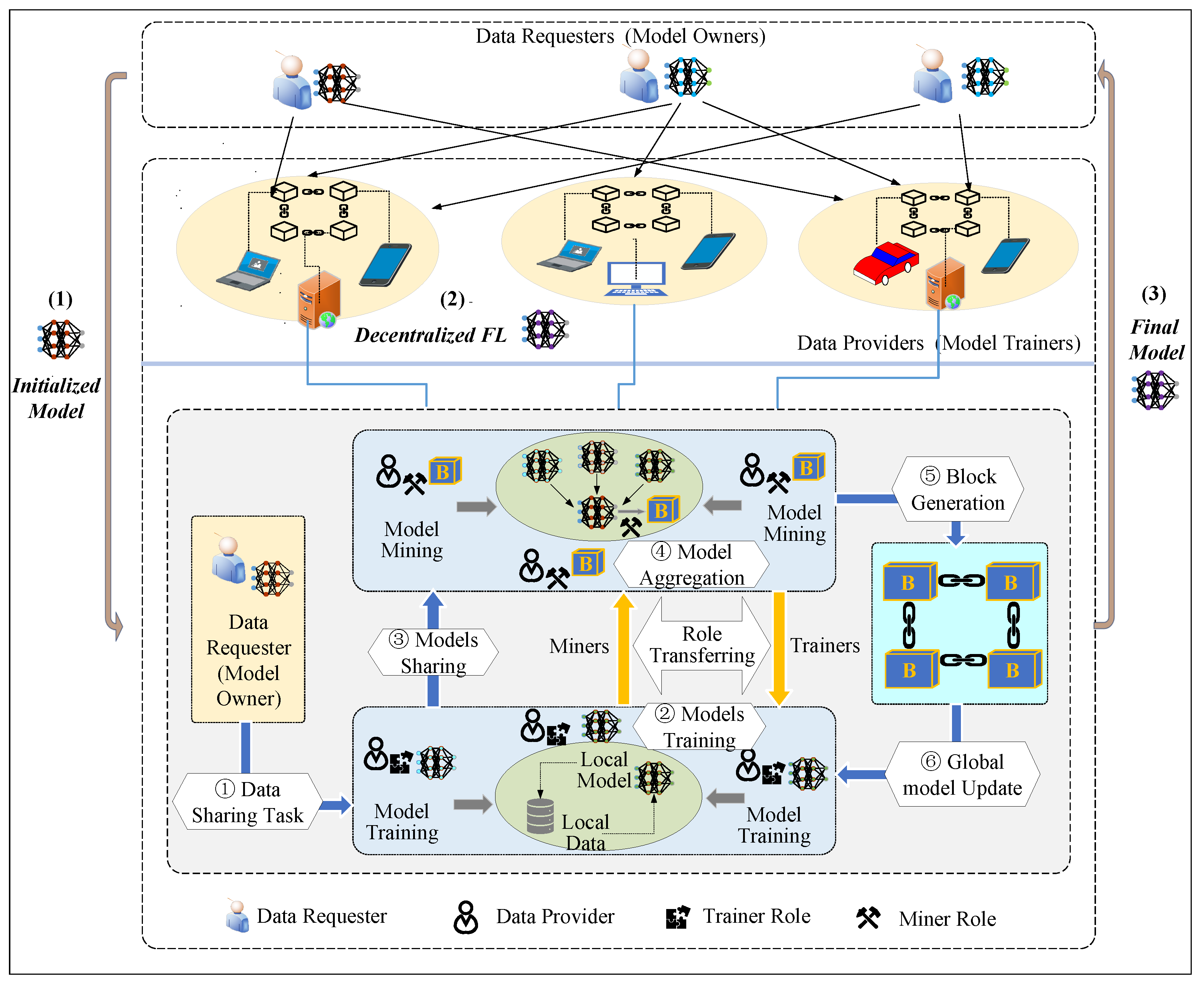

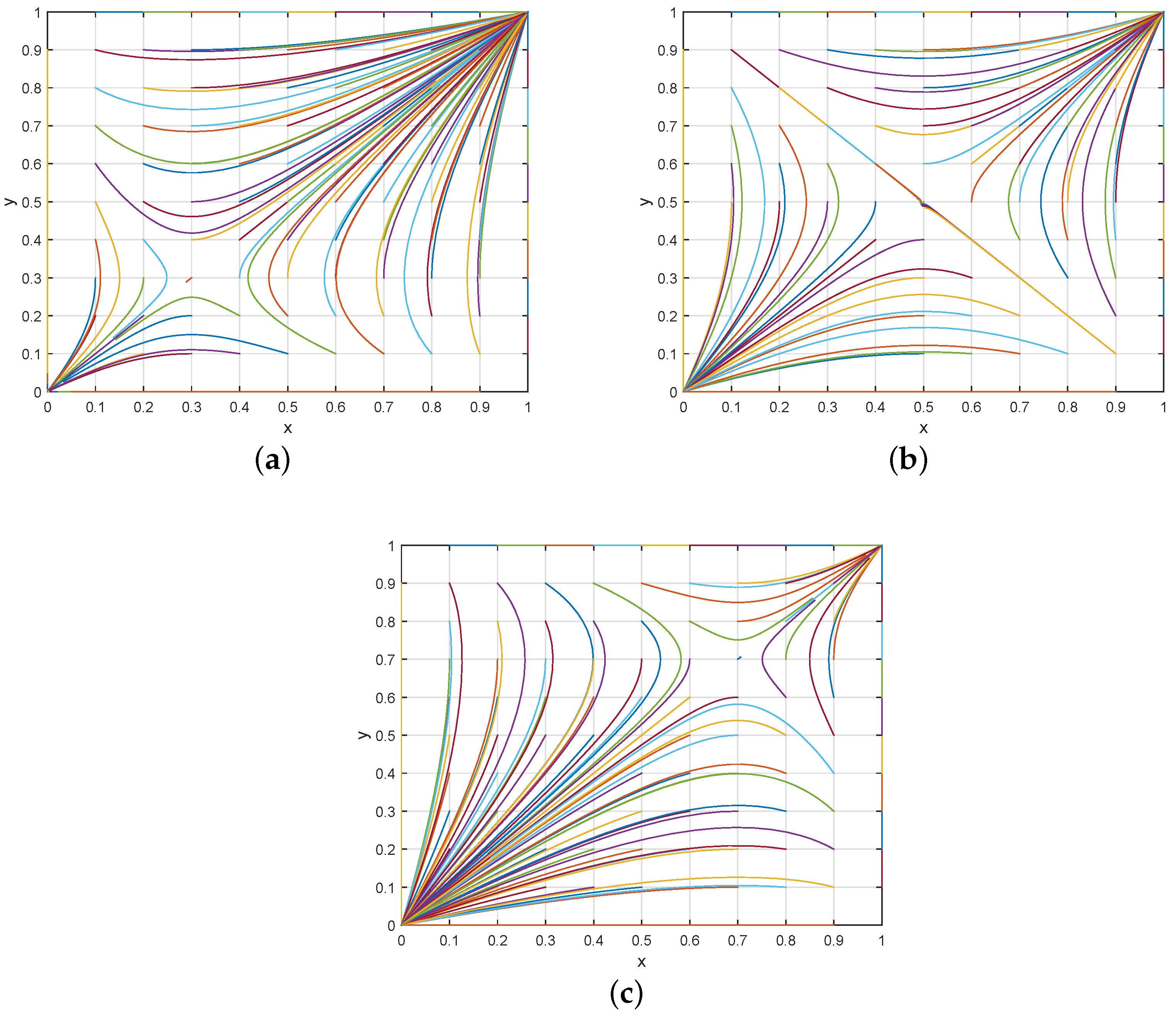
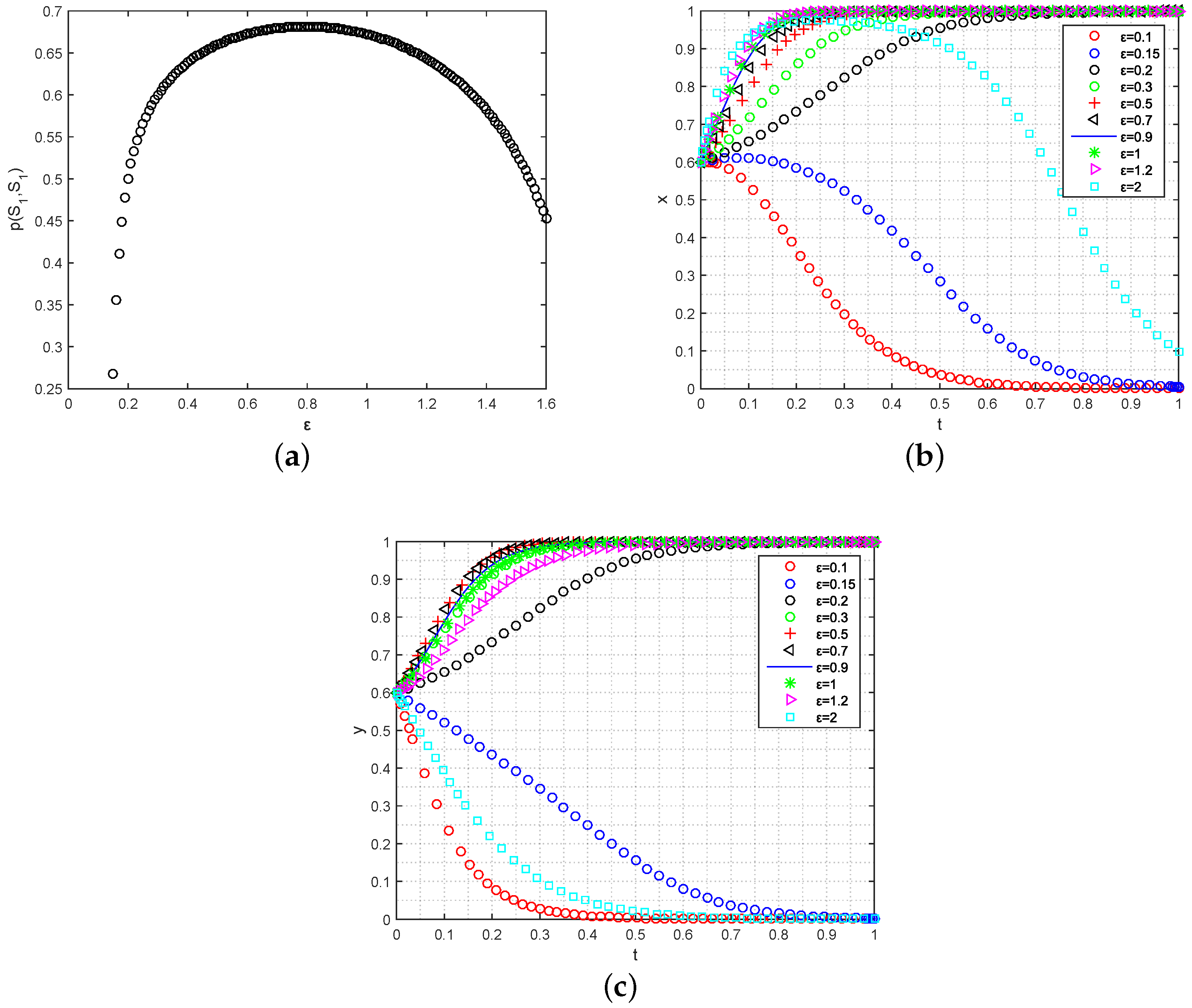
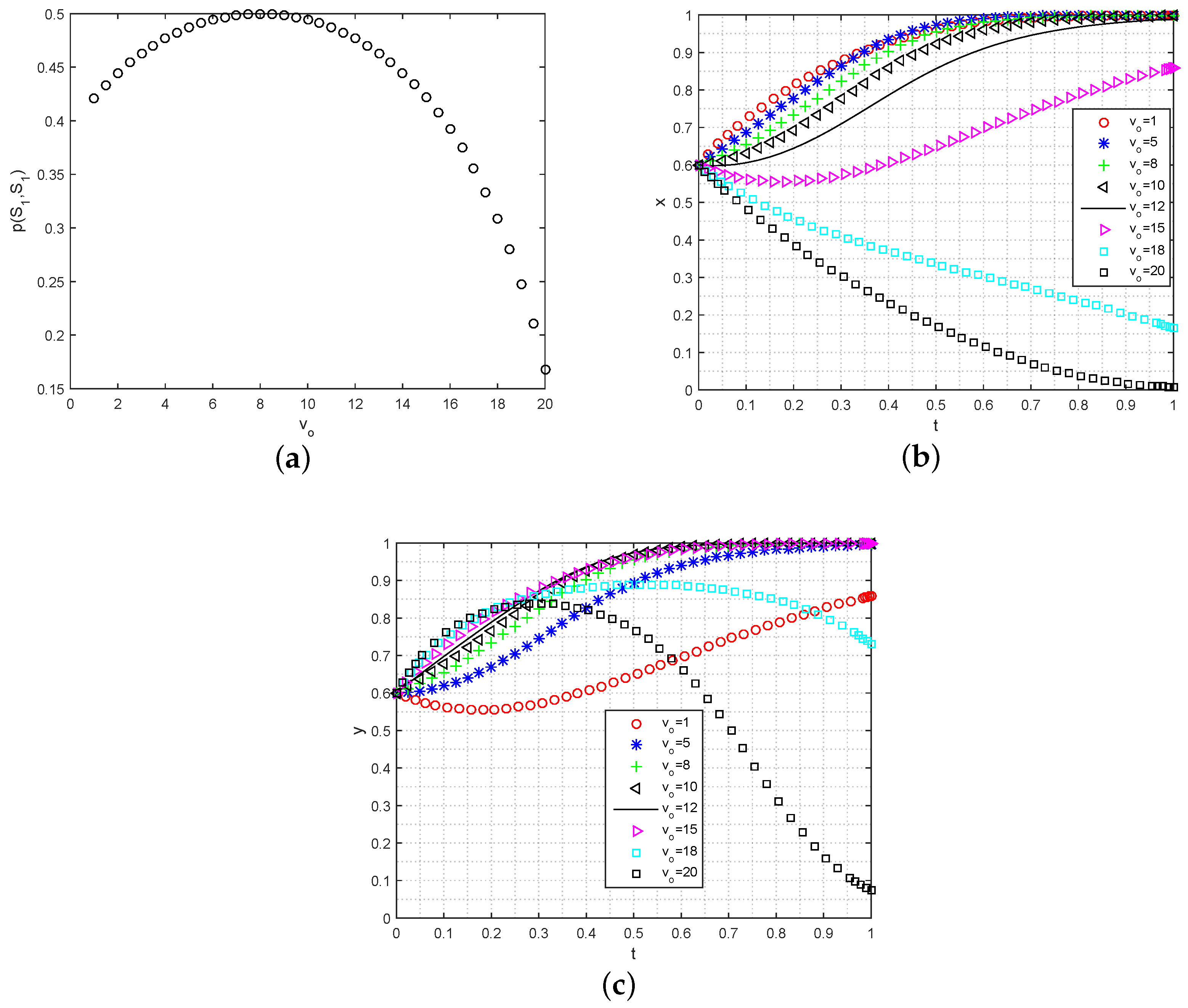
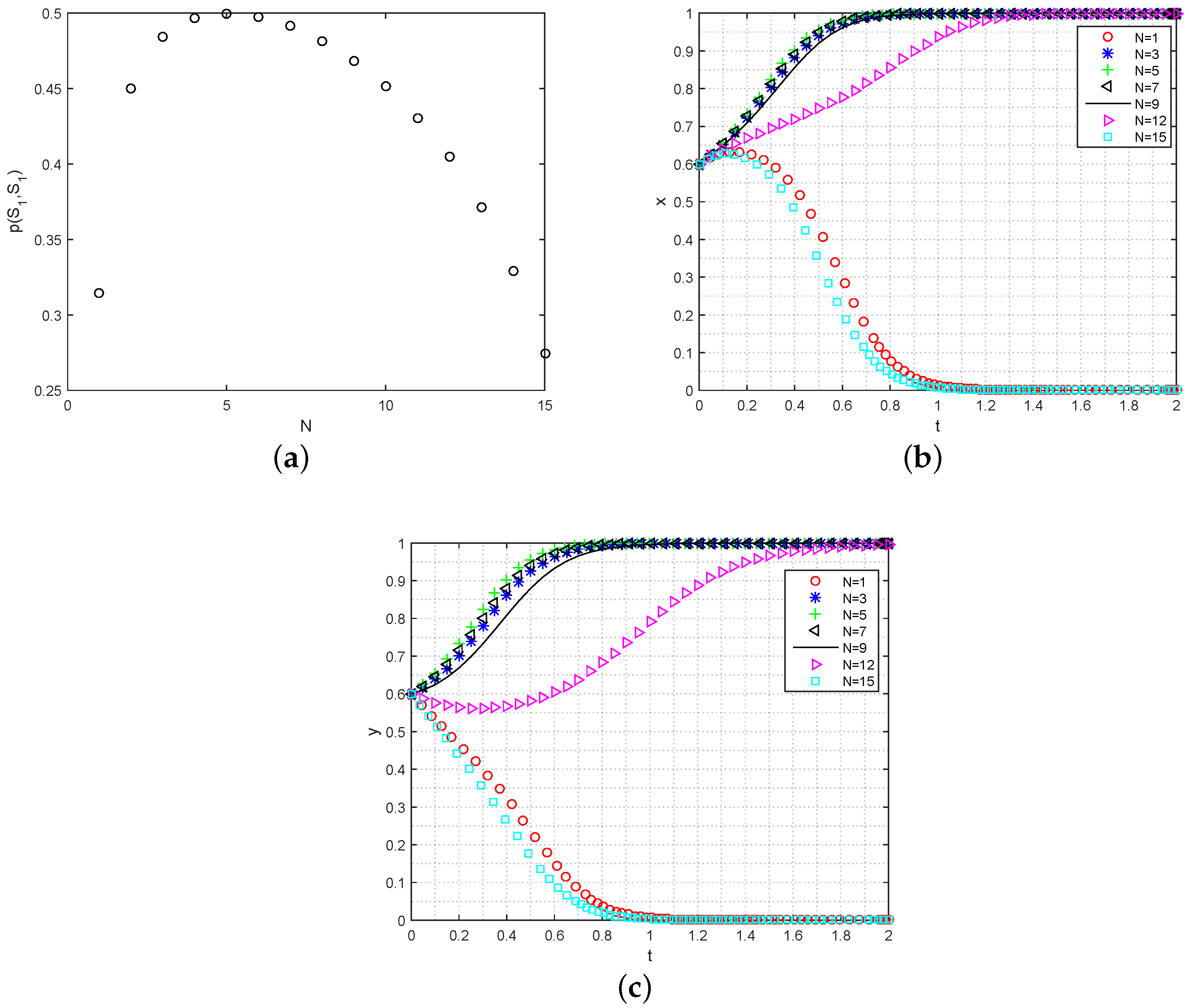
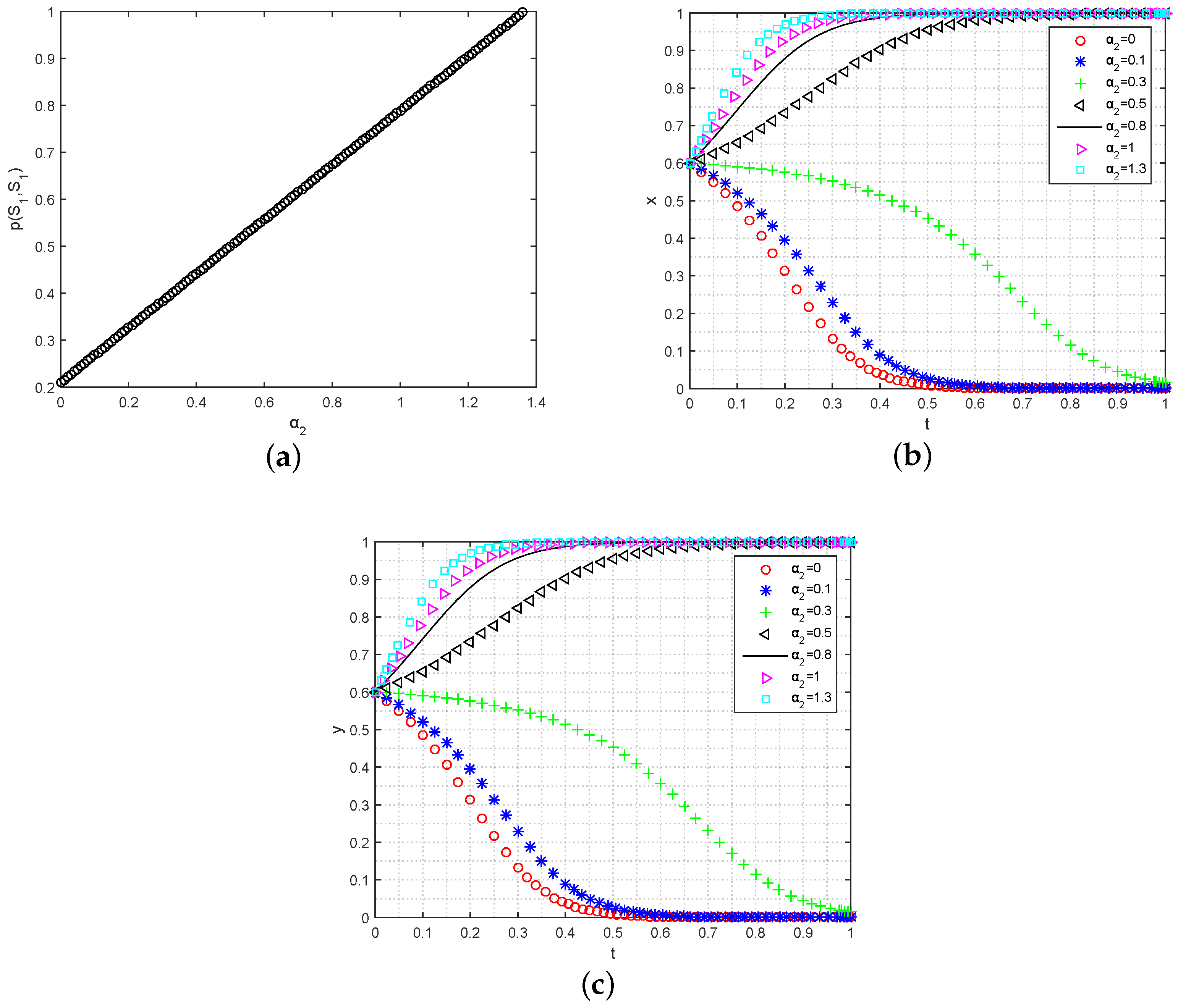
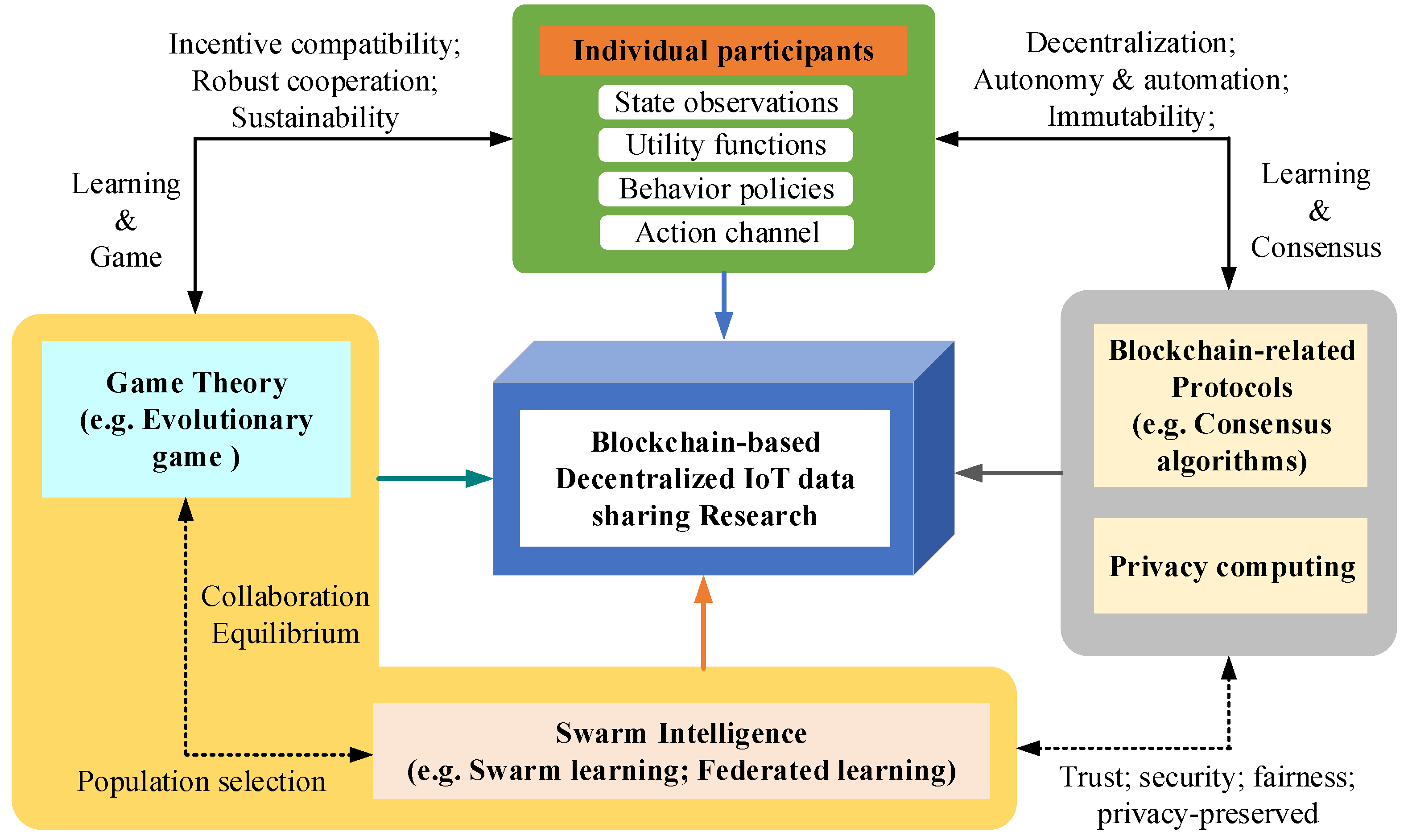
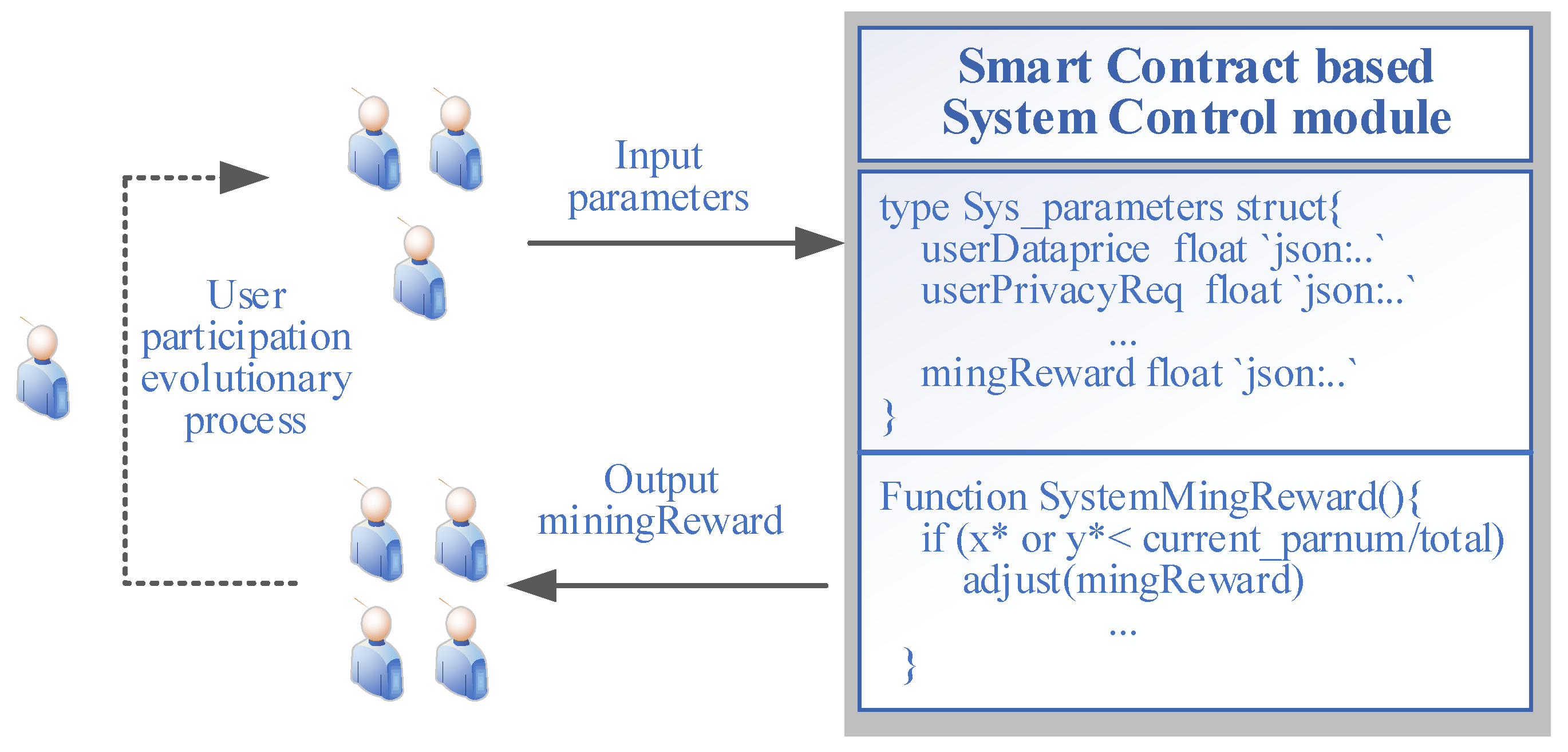
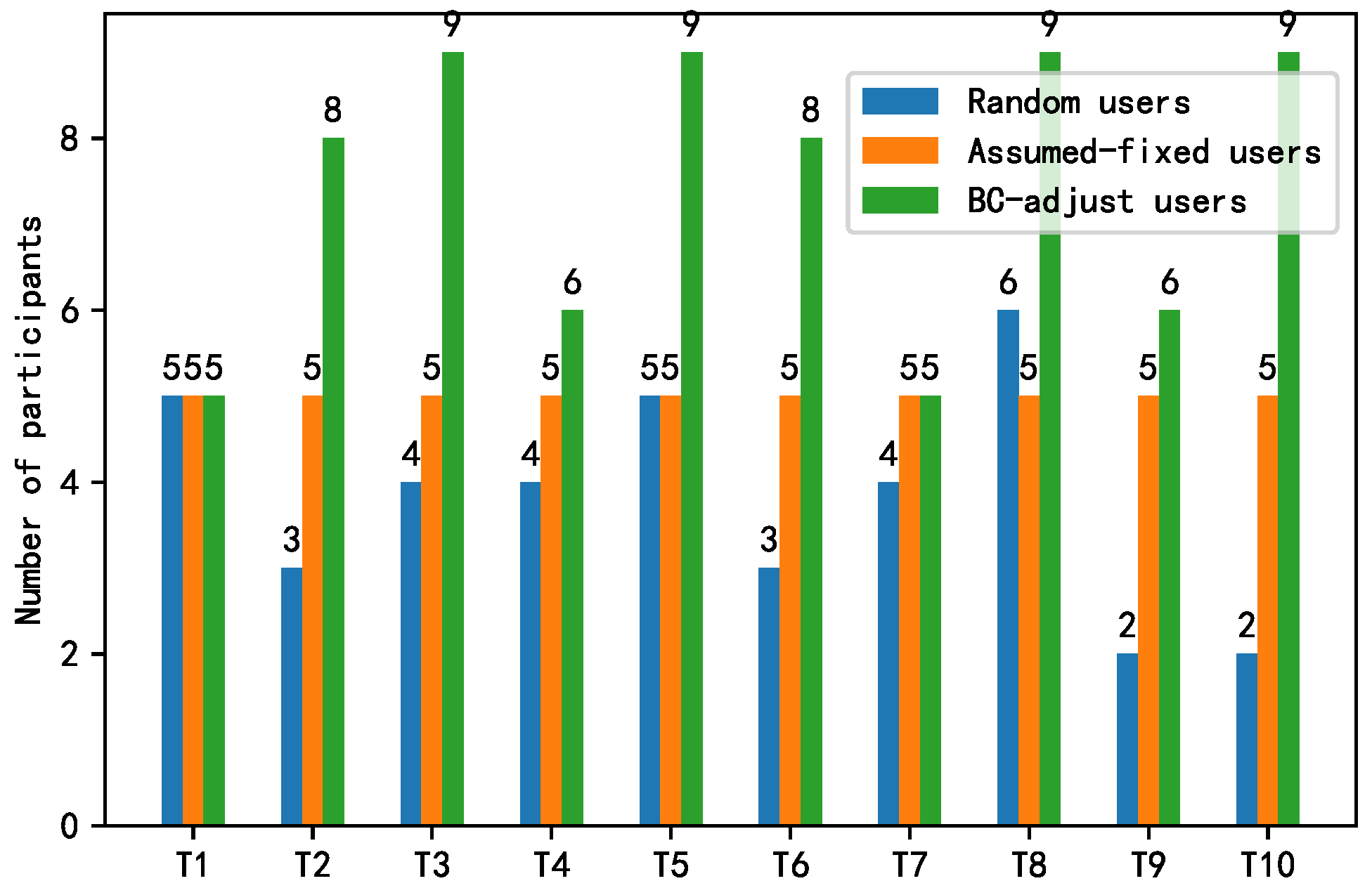
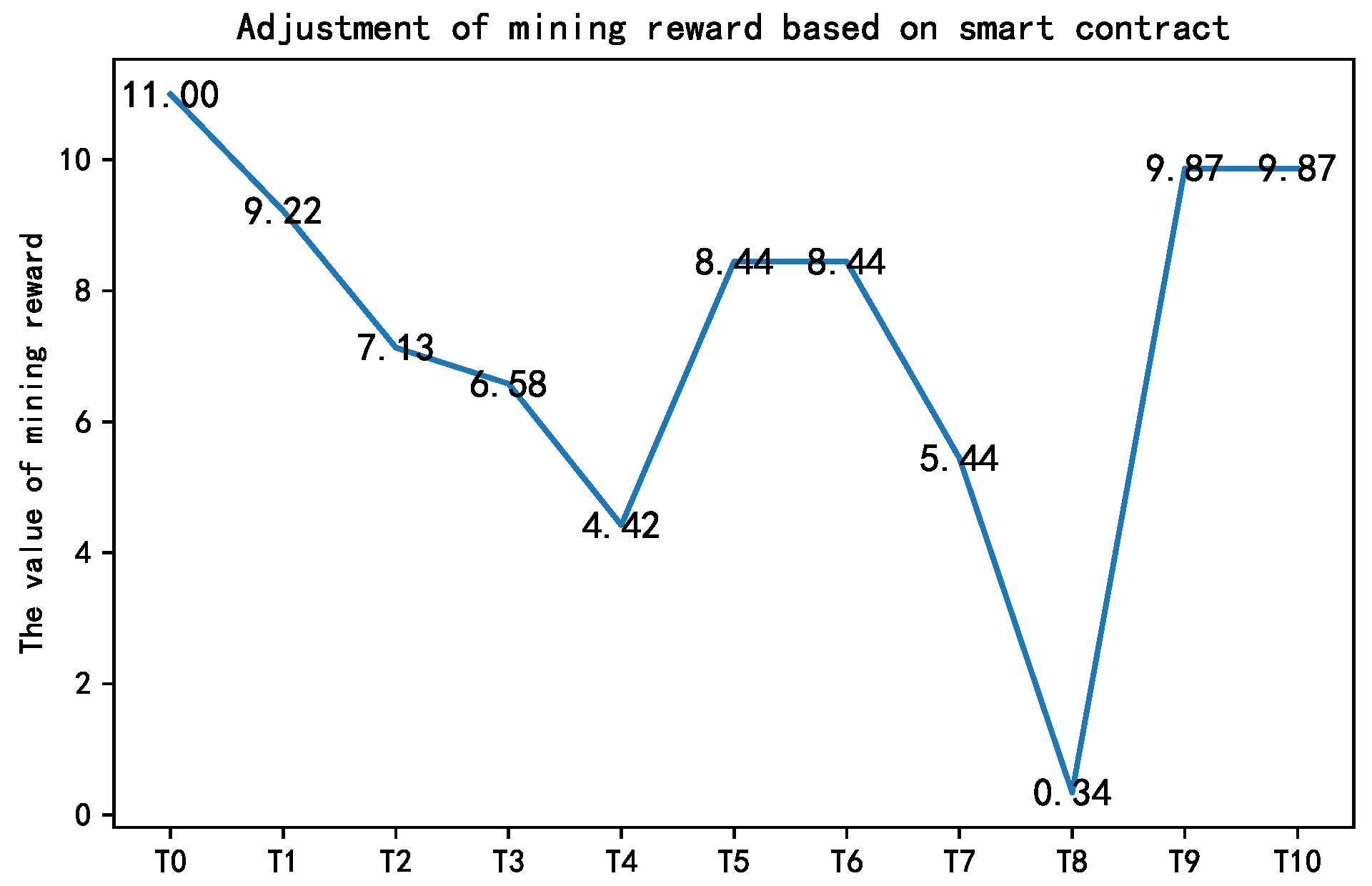
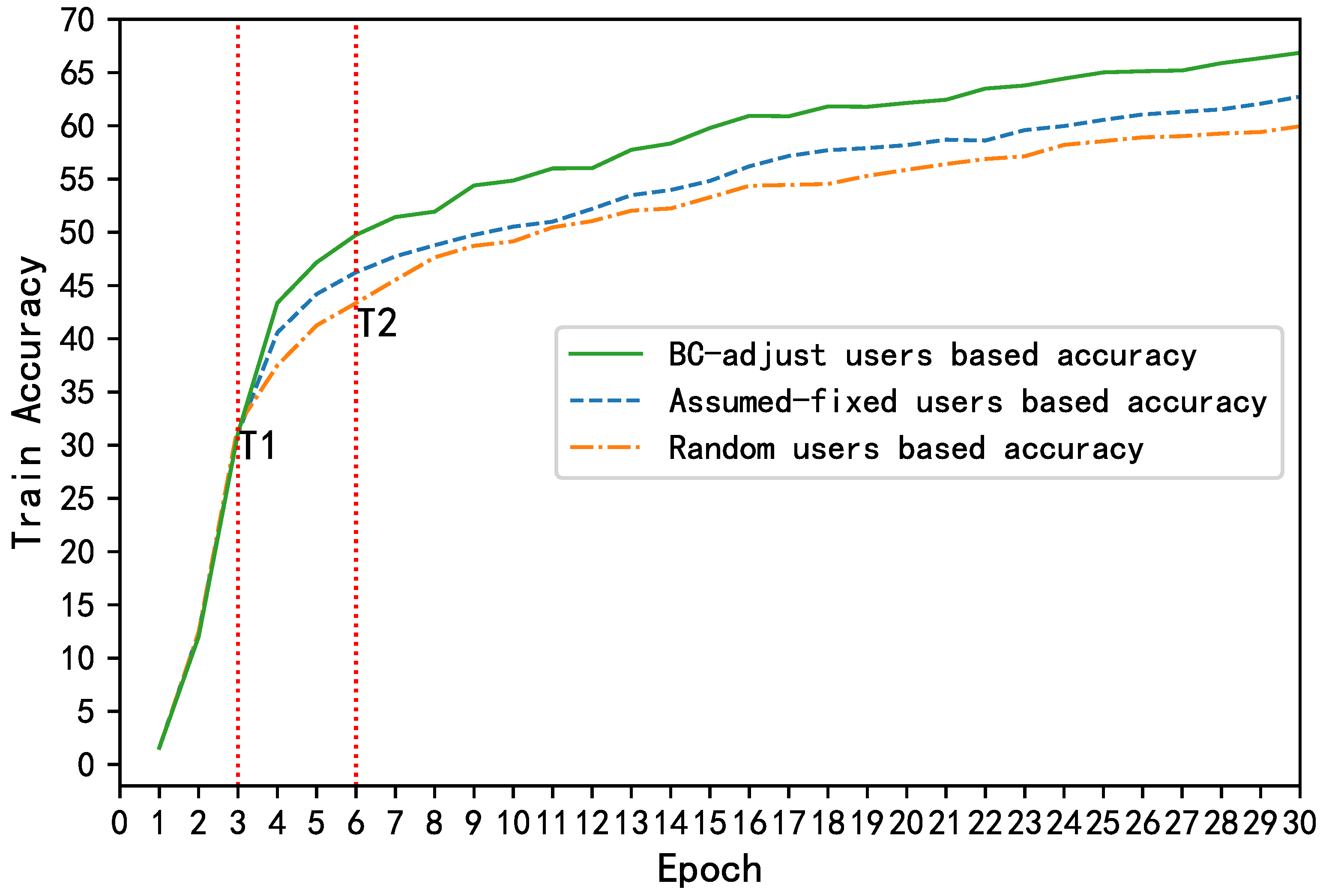
| Symbols | Description |
|---|---|
| The data value (i.e., the predefined data price for DOs from DRs) | |
| Extra model profit for DOs caused by the model-enabled services | |
| The profit of data (model) flows, such as the secondhand exchange by DRs | |
| The proportion of allocated to DR | |
| The coefficient of extra profit | |
| The predefined number of data (model) transfers | |
| The constant mining reward from the BCFL network | |
| The adjustment parameter of the mining reward, indicating the dynamic adjustment of the mining reward rule | |
| Extra profit for DRs caused by the model-enabled services | |
| The computing cost in training local models | |
| The constant cost of data privacy leakage | |
| The risk level of privacy leakage | |
| All costs related to blockchain operations, including transmitting, mining, invoking SC (such as gas costs), and so on |
| Data Owner | |||
|---|---|---|---|
| Data Consumer | |||
| Equilibrium Point | Det (JM) | Tr (JM) | Local Stability |
|---|---|---|---|
| (0, 0) | + | − | ESS |
| (0, 1) | + | + | Unstable |
| (1, 0) | + | + | Unstable |
| (1, 1) | + | − | ESS |
| (x*, y*) | Uncertain | 0 | Saddle Point |
Disclaimer/Publisher’s Note: The statements, opinions and data contained in all publications are solely those of the individual author(s) and contributor(s) and not of MDPI and/or the editor(s). MDPI and/or the editor(s) disclaim responsibility for any injury to people or property resulting from any ideas, methods, instructions or products referred to in the content. |
© 2023 by the authors. Licensee MDPI, Basel, Switzerland. This article is an open access article distributed under the terms and conditions of the Creative Commons Attribution (CC BY) license (https://creativecommons.org/licenses/by/4.0/).
Share and Cite
Cheng, Z.; Wang, B.; Pan, Y.; Liu, Y. Strategic Analysis of Participants in BCFL-Enabled Decentralized IoT Data Sharing. Mathematics 2023, 11, 4520. https://doi.org/10.3390/math11214520
Cheng Z, Wang B, Pan Y, Liu Y. Strategic Analysis of Participants in BCFL-Enabled Decentralized IoT Data Sharing. Mathematics. 2023; 11(21):4520. https://doi.org/10.3390/math11214520
Chicago/Turabian StyleCheng, Ziwen, Bowen Wang, Yongqi Pan, and Yi Liu. 2023. "Strategic Analysis of Participants in BCFL-Enabled Decentralized IoT Data Sharing" Mathematics 11, no. 21: 4520. https://doi.org/10.3390/math11214520
APA StyleCheng, Z., Wang, B., Pan, Y., & Liu, Y. (2023). Strategic Analysis of Participants in BCFL-Enabled Decentralized IoT Data Sharing. Mathematics, 11(21), 4520. https://doi.org/10.3390/math11214520






